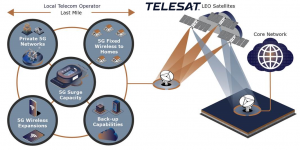Last week, Telesat announced the successful completion of a demonstration in Brazil of Low Earth Orbit (LEO) backhaul for a 5G network. The performance results achieved were said to be close to fibre connectivity. Telesat conducted the world’s first 5G backhaul demonstration 3 years ago, with round trip latency of 18-40 milliseconds, and supporting video chatting, web browsing and simultaneous streaming of up to 8K video.

In Canada, and in many areas around the world, 5G technology is being used in a fixed wireless application to provide residential broadband. Wireless is a cost effective way to connect homes and businesses in low density areas, especially where considerations of Canadian geography and climate increase the challenges associated with placing wireline facilities.
Today, Starlink terminals require a very high initial payment and monthly service fees are about double the prices paid by urban subscribers for similar terrestrial services. Earlier this month, the Government of Canada announced that it would be providing a $900 per household subsidy for residents in a number of Manitoba communities to help offset the upfront costs associated with subscribing to Starlink.
One of the biggest challenges for building terrestrial rural broadband networks has been the umbilical connection. In the case of wireless, network operators have to provide backhaul from the tower to the network. The Telesat announcement, using LEO for 5G backhaul, adds another technology solution for consideration to solve that problem.
Customer premises equipment for 5G typically is easier to install and has a much lower cost than what is required for LEO. With the LEO connectivity centralized at the 5G base station, the cost of the LEO terminal is effectively shared by all of the subscribers on a tower, which should significantly improve the economics for a LEO-based broadband service. Typically, fixed wireless is priced lower than direct-to-home LEO services.
When will we see LEO supported 5G for fixed wireless in rural Canada? Will this enable a more cost-effective choice for customers of rural broadband service providers?

Mark, This is definitely the way the market will go. The Telesat solution will facilitate terrestrial deployment of 5G in remote areas by providing better backhaul to carriers.
One of the Canadian companies I work with, NuRAN Wireless, provides low cost 2G/3G/4G in Cameroon, DRC, etc in partnership with a couple of Israeli satco’s. The latency on GEOs is fine for most communications but lower cost, latency and higher speed backhaul is a game changer for rural. The question for Canada is how much rural will not have fiber by then.